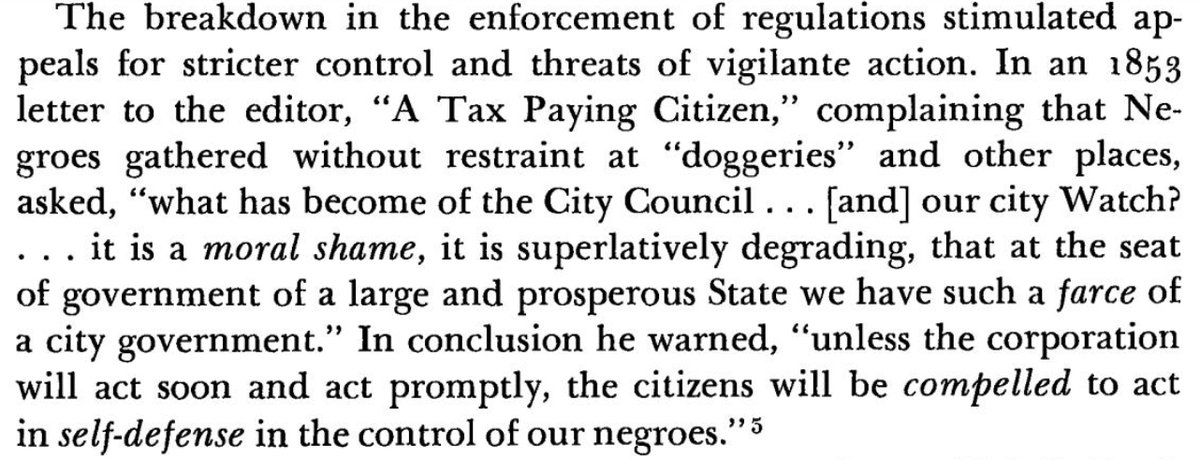Back from researching slave patrols at the Guadalupe County, TX clerk. I& #39;m beginning to get a clearer picture of the relationship between slave patrols and early Texas policing. (Thread) https://twitter.com/Grits4Breakfast/status/1306211204873048065">https://twitter.com/Grits4Bre...
Staff at the clerk& #39;s office couldn& #39;t have been more helpful. And their historical records are impeccably stored, they& #39;ve invested in maintaining all that in a useful format.
Seguin was one of the original Stephen F. Austin settlements and fairly well established when TX became a state in 1845. By 1860, Guadalupe County had 3,689 white residents and 1,748 black folks.
In 1857, Guadalupe County had 13 different slave patrol districts employing five men each to oversee this population (up from 3 districts in 1847). That& #39;s one patrolman for every 27 black people.
Slave patrols were strengthened even further in 1860, and many cities (such as Austin) added city patrols to the county apparatus authorized by the #txlege, after white Texans misinterpreted a series of fires caused by a faulty batch of matches as evidence of Negro insurrection.
This was false, but up to 100 or more black folks and several white (alleged) abolitionists were lynched or otherwise murdered in the aftermath. These events caused slave patrols across the state to be reinvigorated and expanded, historian Kyle Ainsworth told me this week.
Dubbed the "Texas Troubles," the incident with the faulty matches was a more important, proximate cause of Southern insurrection fears when they seceded than Nat Turner& #39;s rebellion decades prior. But today they& #39;re mostly forgotten. https://www.amazon.com/Texas-Terror-Insurrection-Conflicting-Dimensions/dp/0807132837/ref=sr_1_1?dchild=1&keywords=donald+reynolds+Texas+Terror&qid=1600291068&s=books&sr=1-1">https://www.amazon.com/Texas-Ter...
Reading newspapers from early Texas statehood, it& #39;s impossible not to notice the writers& #39; and presumably the public& #39;s obsession with all topics related to slavery. It was a constant topic of discussion in the white press (there was no black press then).
What& #39;s truly remarkable is the extent to which rhetoric supporting slave patrols mirror over-the-top commentary from GOP folks opposing cuts at the @Austin_Police. Check out this example from Austin: https://texashistory.unt.edu/ark:/67531/metapth101208/m1/21/">https://texashistory.unt.edu/ark:/6753...
Except for the words "negroes" and "doggeries," such commentary wouldn& #39;t appear out of place on a @takebackaustin Facebook page.
So Guadalupe County expanding its slave patrol from three districts to 13 in just ten years (from 15 "patterollers" to 65) coincided with a public obsession over the topic that& #39;s difficult to overstate (think COVID coverage in April, then that level of obsession for decades).
Seguin was still a small town and there& #39;s no evidence they suffered a particular runaway problem. Yet they expanded the slave patrol until it was far larger than either the Sheriff or City Marshal& #39;s staff.
They weren& #39;t alone. In 1851, San Antonio had 18 slave patrol districts with 6 employees each. https://losttexasroads.com/history/people/bexar-slave-patrols/
This">https://losttexasroads.com/history/p... was the dominant form of street-level law enforcement in antebellum Texas.
This">https://losttexasroads.com/history/p... was the dominant form of street-level law enforcement in antebellum Texas.
After the Civil War, patrol functions were grafted onto more traditional customer-service functions of local Sheriff and police departments, beginning in Austin and Houston. (By "customer service," I mean victims report crimes and police respond; patrols are proactive.)
In Austin, a new police department was created in 1866 specifically to address “the fact that a large number of Negroes turned loose by their owners are congregating" in the city.
https://gritsforbreakfast.blogspot.com/2020/08/racism-and-origins-of-austin-policing.html">https://gritsforbreakfast.blogspot.com/2020/08/r...
https://gritsforbreakfast.blogspot.com/2020/08/racism-and-origins-of-austin-policing.html">https://gritsforbreakfast.blogspot.com/2020/08/r...
City Council particularly worried about policing "able-bodied Negroes who have abandoned the service of their employers." At that point, the City Marshal& #39;s office took on "patrol" functions that previously were the purview of slave patrols, but with essentially the same purpose.
In the latest Reasonably Suspicious podcast, @iGiveYouMoore of the @AtxJustice Coalition discussed some of this history and the implications for 21st century policing debates. Check it out here: https://gritsforbreakfast.blogspot.com/2020/09/podcast-update-from-march-on-washington.html">https://gritsforbreakfast.blogspot.com/2020/09/p...
See Grits& #39; recent research on these topics rounded up at the bottom of this post: https://gritsforbreakfast.blogspot.com/2020/09/early-texans-couldnt-get-enough-slave.html">https://gritsforbreakfast.blogspot.com/2020/09/e...

 Read on Twitter
Read on Twitter


